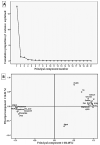Protective Effect of Curcumin against Sodium Salicylate-Induced Oxidative Kidney Damage, Nuclear Factor-Kappa Dysregulation, and Apoptotic Consequences in Rats
- PMID: 34064189
- PMCID: PMC8224369
- DOI: 10.3390/antiox10060826
Protective Effect of Curcumin against Sodium Salicylate-Induced Oxidative Kidney Damage, Nuclear Factor-Kappa Dysregulation, and Apoptotic Consequences in Rats
Abstract
This study examined the effect of sodium salicylates (SS), alone and in combination with curcumin (CUR), on kidney function and architecture in rats. Five rat groups were given 1 mL physiological saline/rat orally, 1 mL olive oil/rat orally, 50 mg CUR/kg bwt orally, 300 mg SS/kg bwt intraperitoneally, or CUR+SS for 15 days. The hematological indices, serum protein profile, serum electrolytes balance, oxidative stress, and lipid peroxidation of kidney tissues were assessed. The histopathological examination and immune expression of Caspase-3 and nuclear factor kappa (NF-κB) were conducted. The findings showed that SS injection induced nephrotoxic activity, including increased serum urea, creatinine, and uric acid levels. It also caused apparent pathological alterations with increased Caspase-3 and NF-κB immuno-expression. In addition, thrombocytopenia, leukocytosis, neutrophilia, hyponatremia, hypochloremia, hypocalcemia, and hypomagnesemia but not hyperkalemia and hyperphosphatemia were evident in SS-injected rats. Moreover, SS exposure increased serum α1 globulin, renal tissue malondialdehyde, and Caspase-3 levels but superoxide dismutase, glutathione peroxidase, and Bcl-2 levels declined. Meanwhile, CUR significantly counteracted the SS harmful impacts on kidneys but SS+CUR co-administration induced an anemic condition. Overall, CUR has an evident protective role against SS-induced renal damage, but the disturbed hematological alterations should be carefully taken into consideration in their combined use.
Keywords: Caspase-3; NF-kappa B; anemia; curcumin; kidney; sodium salicylate.
Conflict of interest statement
The authors declare no conflict of interest.
Figures






Similar articles
-
Curcumin mitigates neurotoxic and neurobehavioral changes of gentamicin and sodium salicylate in rats by adjusting oxidative stress and apoptosis.Life Sci. 2021 Jan 15;265:118824. doi: 10.1016/j.lfs.2020.118824. Epub 2020 Dec 2. Life Sci. 2021. PMID: 33278387
-
Curcumin attenuates gentamicin and sodium salicylate ototoxic effects by modulating the nuclear factor-kappaB and apoptotic pathways in rats.Environ Sci Pollut Res Int. 2022 Dec;29(60):89954-89968. doi: 10.1007/s11356-022-21932-1. Epub 2022 Jul 20. Environ Sci Pollut Res Int. 2022. PMID: 35859240 Free PMC article.
-
Oral nanoparticulate curcumin combating arsenic-induced oxidative damage in kidney and brain of rats.Toxicol Ind Health. 2016 Mar;32(3):410-21. doi: 10.1177/0748233713498455. Epub 2013 Oct 8. Toxicol Ind Health. 2016. PMID: 24105067
-
The ameliorative effect of curcumin on hepatic CYP1A1 and CYP1A2 genes dysregulation and hepatorenal damage induced by fenitrothion oral intoxication in male rats.Pestic Biochem Physiol. 2021 Nov;179:104959. doi: 10.1016/j.pestbp.2021.104959. Epub 2021 Aug 27. Pestic Biochem Physiol. 2021. PMID: 34802538
-
Protective effect of curcumin against cyclosporine A‑induced rat nephrotoxicity.Mol Med Rep. 2018 Apr;17(4):6038-6044. doi: 10.3892/mmr.2018.8591. Epub 2018 Feb 12. Mol Med Rep. 2018. PMID: 29436671
Cited by
-
Mancozeb-induced hepatotoxicity: protective role of curcumin in rat animal model.Toxicol Res (Camb). 2023 Jan 16;12(1):107-116. doi: 10.1093/toxres/tfac085. eCollection 2023 Feb. Toxicol Res (Camb). 2023. PMID: 36866214 Free PMC article.
-
Hepato-renal protective impact of nanocapsulated Petroselinum crispum and Anethum graveolens essential oils added in fermented milk against some food additives via antioxidant and anti-inflammatory effects: In silico and in vivo studies.Heliyon. 2024 Aug 30;10(17):e36866. doi: 10.1016/j.heliyon.2024.e36866. eCollection 2024 Sep 15. Heliyon. 2024. PMID: 39286161 Free PMC article.
-
Protective Effect of Honey and Propolis against Gentamicin-Induced Oxidative Stress and Hepatorenal Damages.Oxid Med Cell Longev. 2021 Sep 2;2021:9719906. doi: 10.1155/2021/9719906. eCollection 2021. Oxid Med Cell Longev. 2021. PMID: 34512873 Free PMC article.
-
Toll-like receptors and nuclear factor kappa B signaling pathway involvement in hepatorenal oxidative damage induced by some food preservatives in rats.Sci Rep. 2023 Apr 12;13(1):5938. doi: 10.1038/s41598-023-32887-9. Sci Rep. 2023. PMID: 37045926 Free PMC article.
-
Protective impacts of Artemisia annua against hepatic toxicity induced by gentamicin.Toxicol Res (Camb). 2023 Dec 27;13(1):tfad121. doi: 10.1093/toxres/tfad121. eCollection 2024 Feb. Toxicol Res (Camb). 2023. PMID: 38162595 Free PMC article.
References
-
- Abd-Elhakim Y.M., Abdel-Motal S.M., Malhat S.M., Mostafa H.I., Moselhy A.A., Beheiry R.R., Said E.N. Curcumin mitigates neurotoxic and neurobehavioral changes of gentamicin and sodium salicylate in rats by adjusting oxidative stress and apoptosis. Life Sci. 2021;265:118824. doi: 10.1016/j.lfs.2020.118824. - DOI - PubMed
-
- McMahon T.F., Stefanski S.A., Wilson R.E., Blair P.C., Clark A.-M., Birnbaum L.S. Comparative acute nephrotoxicity of salicylic acid, 2, 3-dihydroxybenzoic acid, and 2, 5-dihydroxybenzoic acid in young and middle aged Fischer 344 rats. Toxicology. 1991;66:297–311. doi: 10.1016/0300-483X(91)90201-B. - DOI - PubMed
Grants and funding
LinkOut - more resources
Full Text Sources
Research Materials

